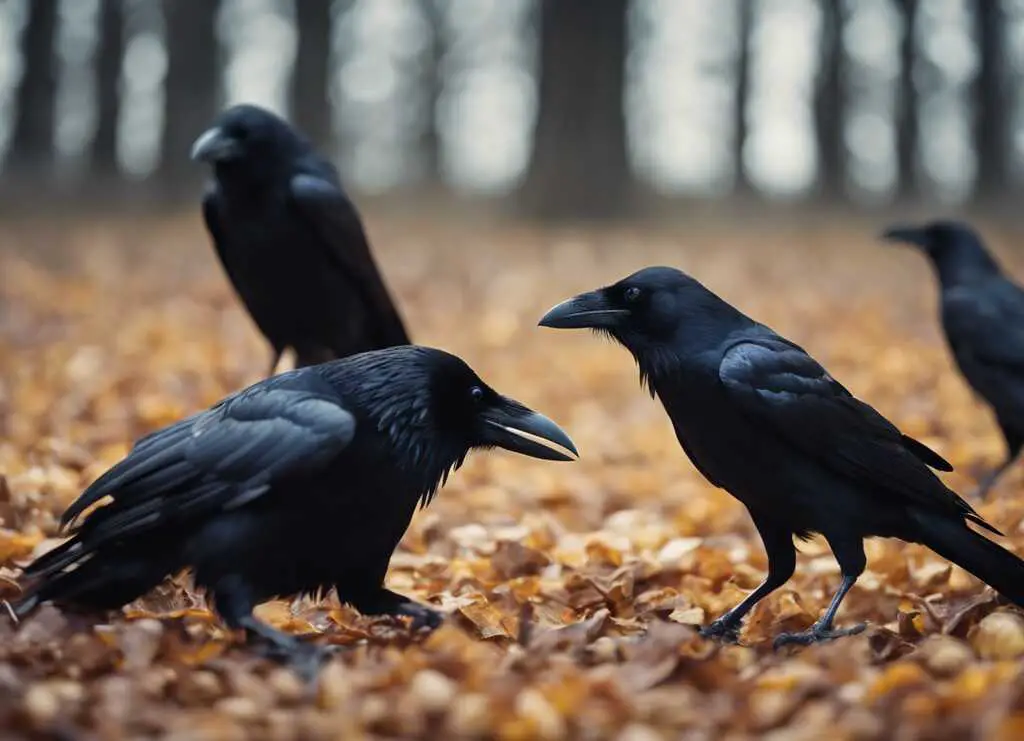In this article, we will dive into the intriguing world of ravens and crows. While they may appear similar at a glance, these birds possess distinct characteristics that set them apart. Join us as we uncover the differences between these fascinating creatures and explore their unique behaviors and traits.
Table of Contents
- 1 Differences in Physical Appearance Between Ravens and Crows
- 2 Side By Side Comparison
- 3 Habitat and Geographic Distribution of Ravens and Crows
- 4 Behaviors and Social Interactions of Ravens Versus Crows
- 5 Diet Variations: What Ravens and Crows Prefer to Eat
- 6 Cultural Significance and Symbolism of Ravens and Crows
- 7 Conclusion
- 8 Author
Differences in Physical Appearance Between Ravens and Crows
Physical Size:
One of the most noticeable differences between ravens and crows is their size. Ravens are typically larger than crows, with a wingspan of around 3.5 to 4 feet and weighing up to 4 pounds. On the other hand, crows have a wingspan of about 2.5 feet and weigh around 1 pound. This significant size contrast is one of the key factors in distinguishing between the two birds.
Tail Shape:
Another characteristic that sets ravens apart from crows is their tail shape. Ravens have wedge-shaped tails, which are evenly spread out when they are in flight. In comparison, crows have fan-shaped tails that appear squared off at the end. This distinction in tail shape can be a helpful visual cue when trying to identify these birds in the wild.
Feathers:
When closely observed, the feather texture of ravens and crows also differs. Ravens have a more shaggy and noticeable ruff of feathers around their throat area, giving them a slightly scruffier appearance compared to crows. Crows, on the other hand, have smoother plumage overall, with a sleeker and more streamlined look.
Vocalizations:
While physical characteristics are the primary means of distinguishing between ravens and crows, their vocalizations also offer some insight. Ravens are known for their deep, guttural croaking calls that are often described as a low, resonant “cronk.” In contrast, crows have a more varied vocal repertoire, including harsh caws, clicks, and cooing sounds. Paying attention to their calls can provide additional clues when differentiating between these two birds.
Behavior:
In addition to their physical appearance, the behavior of ravens and crows can also help in identification. Ravens are often seen alone or in pairs, as they tend to be less social than crows. They are known for their playful antics and aerial acrobatics. Crows, on the other hand, are highly social birds that form large flocks, especially during the non-breeding season. Observing their interactions with other birds can provide valuable insights into whether you are looking at a raven or a crow.
While ravens and crows may appear similar at first glance, there are several key physical differences that can help in distinguishing between the two. By paying attention to size, tail shape, feathers, vocalizations, and behavior, birdwatchers can develop a keen eye for identifying these fascinating corvid species in the wild.
Side By Side Comparison
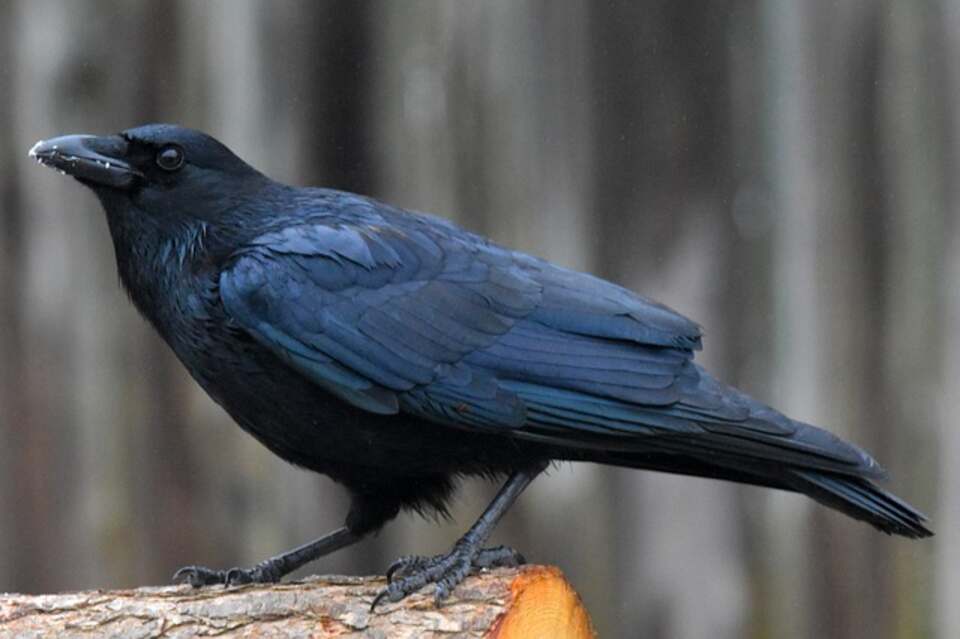
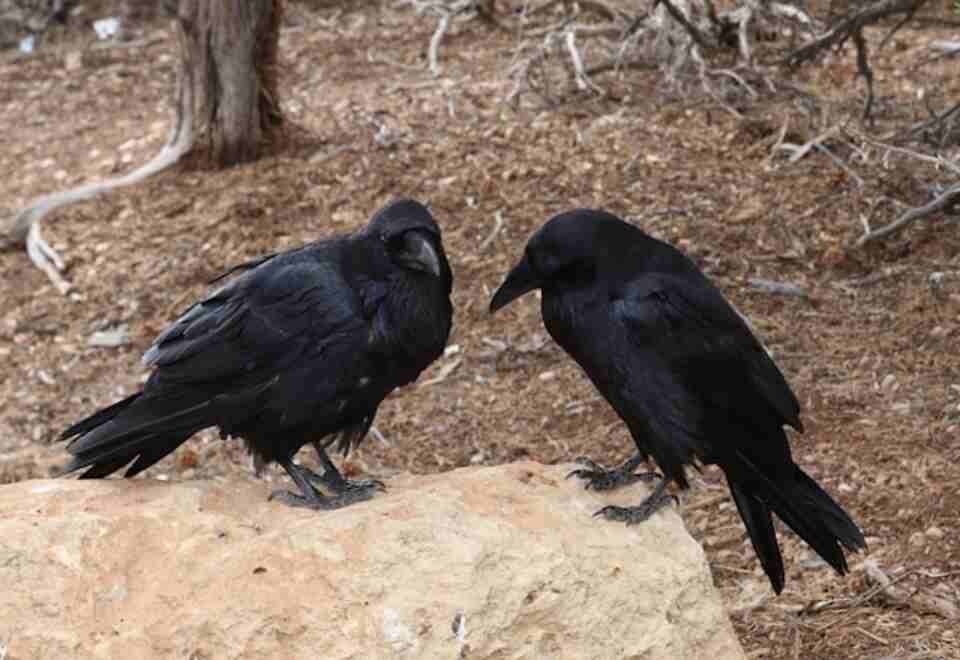
Habitat and Geographic Distribution of Ravens and Crows
Ravens and crows are fascinating birds that are often confused due to their similar appearance. One of the key distinctions between these two corvid species lies in their habitat and geographic distribution.
Habitat of Ravens
Ravens, known for their intelligence and adaptability, are commonly found in a variety of habitats across the Northern Hemisphere. They prefer rugged, mountainous areas, coastal regions, forests, and open plains. Ravens are highly adaptable birds and can thrive in diverse environments, from deserts to tundra. These birds often build their nests in tall trees, cliffs, or even human-made structures.
Geographic Distribution of Ravens
Ravens have a wide geographic range that spans across Europe, Asia, North Africa, and North America. In North America, the common raven can be found from Alaska and northern Canada to Central America. They are also present in parts of Europe, Asia, and North Africa. Ravens are known for their distinctive deep croaking calls and large size compared to crows.
Habitat of Crows
Crows are highly social birds that tend to inhabit a wide range of habitats, including forests, grasslands, agricultural areas, and urban environments. They are commonly found in close proximity to human settlements, where they can scavenge for food. Crows build their nests in trees, shrubs, or even on buildings.
Geographic Distribution of Crows
Crows have a global distribution, with various species found on every continent except Antarctica. The American crow is widespread across North America, while the carrion crow is common in Europe and parts of Asia. Crows are known for their distinctive cawing calls and sleek, black plumage.
The Key Differences in Habitat and Distribution
While both ravens and crows can be found in a variety of habitats, ravens typically prefer more remote and rugged landscapes compared to crows. Ravens have a broader geographic distribution, spanning across multiple continents, while crows are more widely distributed within specific regions. Understanding the habitat preferences and geographic ranges of these birds can help in identifying and appreciating their presence in the wild.
The habitat and geographic distribution of ravens and crows play a significant role in shaping their behavior and ecological roles within ecosystems. By exploring the diverse environments where these birds thrive, we can gain a deeper appreciation for the unique characteristics of each species.
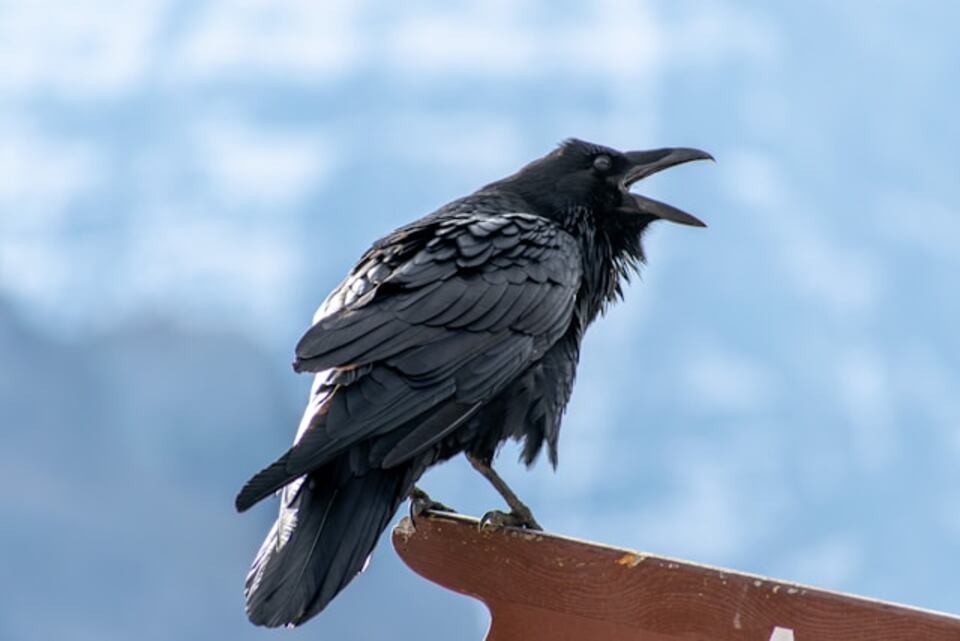
Behaviors and Social Interactions of Ravens Versus Crows
Ravens and crows are often mistaken for one another due to their similar appearances. While they both belong to the Corvidae family and share certain characteristics, they also have distinct differences in behaviors and social interactions that set them apart.
Behaviors of Ravens
Ravens are known for their remarkable intelligence and problem-solving skills. These birds have been observed using tools, mimicking sounds, and even playing games. They are highly curious creatures, often exploring their surroundings and learning from their experiences. Ravens are also skilled hunters and have been known to work together in pairs or groups to catch prey. Additionally, ravens are excellent at adapting to different environments, which has contributed to their success in various habitats around the world.
Social Interactions of Ravens
Ravens are highly social birds that form strong bonds within their groups. They communicate through a complex system of vocalizations and body language, enabling them to coordinate activities such as hunting, nesting, and defending their territory. Ravens are also known to engage in playful behaviors with one another, further strengthening their social connections. Within a group of ravens, there is typically a hierarchy based on age, experience, and dominance, which helps maintain order and organization within the flock.
Behaviors of Crows
Crows are also intelligent birds with the ability to problem solve and display creativity. They are opportunistic feeders, often scavenging for food in urban areas and taking advantage of various resources. Crows are highly adaptable and can thrive in diverse environments, making them a common sight in both rural and urban settings. These birds are known for their loud cawing calls, which they use to communicate with one another and alert their group of potential threats or sources of food.
Social Interactions of Crows
Crows are highly social birds that form large and tightly-knit family groups. They work together to build nests, protect their territory, and raise their young. Crows also engage in communal roosting, where they gather in large numbers at sunset to rest and socialize. Within a group of crows, there is a strong sense of cooperation and mutual respect, with individuals looking out for one another and sharing resources as needed. Crows also exhibit cooperative breeding behavior, where non-breeding members of the group help care for the offspring of dominant breeding pairs.
While ravens and crows share certain behaviors and social interactions, such as their intelligence and social nature, they also have distinct differences that reflect their unique characteristics. Understanding these differences can help bird enthusiasts and researchers appreciate the diversity and complexity of these fascinating avian species.

Diet Variations: What Ravens and Crows Prefer to Eat
Ravens and crows are often associated with mystery and intelligence in various cultures worldwide. Apart from their fascinating characteristics and behaviors, these birds also have their dietary preferences that set them apart. Understanding what ravens and crows prefer to eat can shed light on their ecological roles and behaviors in the wild.
Diet Variations of Ravens
Ravens are opportunistic feeders known for their diverse diet. These large birds have a varied palate and are skilled hunters. One of the key components of a raven’s diet is meat. They are scavengers and often feed on carrion, making them essential in the ecosystem for their ability to clean up decaying animals. Ravens also prey on small animals like rodents, insects, and even other birds. Additionally, these birds are known to consume fruits, berries, and grains when available.
Dietary Habits of Crows
Crows, on the other hand, have somewhat similar dietary preferences to ravens but with some distinctions. Crows are omnivores and will eat almost anything, making them highly adaptable to different environments. Their diet primarily consists of fruits, seeds, insects, small animals, and even human food scraps. Crows are known to be crafty foragers and have been observed using innovative techniques to extract food from various sources.
Variances in Feeding Behavior
While both ravens and crows share certain dietary habits, there are notable differences in their feeding behaviors. Ravens, being larger in size, are more adept at hunting and overpowering prey. They are known to cache food for later consumption, showing a high level of intelligence in their feeding strategies. Crows, although also intelligent, tend to forage in groups and communicate with each other while feeding, forming strong social bonds within their communities.
Impact on Ecosystem
The dietary preferences of ravens and crows play a crucial role in maintaining the balance of ecosystems. Ravens, with their scavenging habits, help prevent the spread of diseases by consuming carrion. Their predatory nature also controls populations of small animals, thus influencing the dynamics of the food chain. Crows, with their diverse diet and foraging behavior, contribute to seed dispersal and insect control, influencing plant growth and insect populations in their habitats.
Human Interaction and Feeding
Both ravens and crows are highly adaptable to human environments, often foraging in urban areas and taking advantage of human food sources. While this adaptability has helped these birds thrive in changing landscapes, it has also led to conflicts with humans, especially regarding crop damage and nest predation. Understanding their dietary preferences can aid in managing interactions with these intelligent birds positively.
Ravens and crows exhibit fascinating dietary habits that reflect their adaptability and intelligence. By studying and respecting their feeding behaviors, we can appreciate the vital roles these birds play in ecosystems and foster coexistence with them in our shared environments.
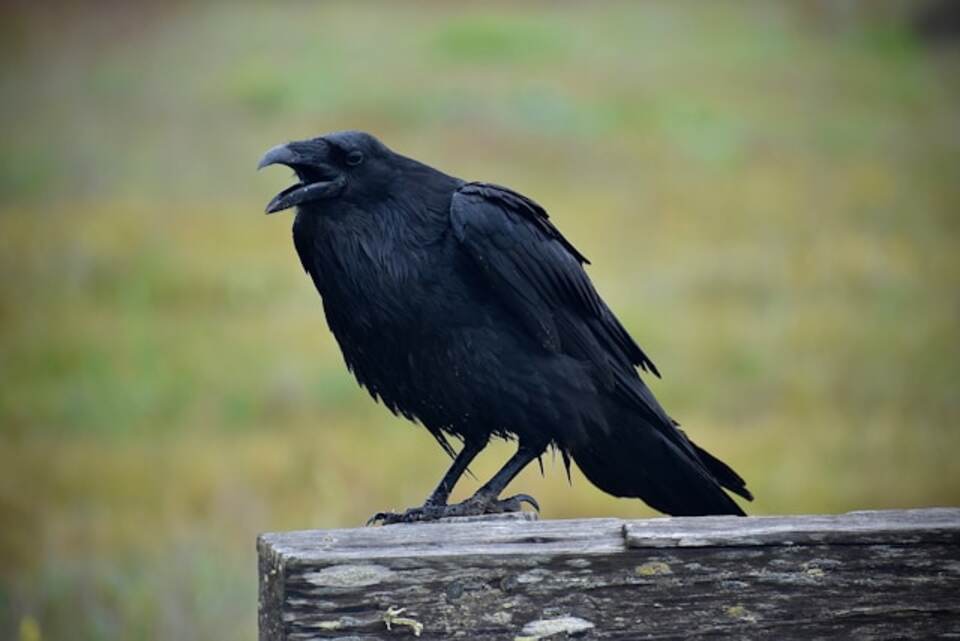
Cultural Significance and Symbolism of Ravens and Crows
People worldwide have long been fascinated by the mysterious allure of ravens and crows. These black birds have permeated various cultures and belief systems, symbolizing a wide array of meanings and interpretations. Both ravens and crows are highly intelligent creatures, known for their problem-solving abilities and complex social behaviors. In this article, we will delve into the cultural significance and symbolism of these intriguing birds.
Cultural Depictions in Mythology and Folklore
Ravens and crows have played significant roles in mythology and folklore across different civilizations throughout history. In Norse mythology, ravens were associated with Odin, the god of wisdom, war, and death. Odin was often depicted with two ravens, Huginn and Muninn, who served as his messengers, gathering information from the world for him. The presence of these birds symbolized knowledge, insight, and the mysteries of the universe.
Crows, on the other hand, have been portrayed differently in various cultures. In some Native American traditions, crows were considered to be tricksters, shape-shifters, and symbols of transformation. In Japanese folklore, the Yatagarasu, a three-legged crow, was seen as a symbol of guidance and divine intervention. These contrasting depictions highlight the divergent cultural interpretations of these birds.
Symbolism of Ravens and Crows in Different Cultures
The symbolism of ravens and crows varies widely across different cultures. In many Western societies, ravens are often associated with death and negativity. Their black plumage and haunting calls have led to them being viewed as harbingers of doom and misfortune. However, in some Native American and Celtic cultures, ravens are revered as spiritual guides and symbols of protection.
Crows, on the other hand, are often seen as symbols of intelligence, adaptability, and transformation. Their ability to thrive in diverse environments and their keen observation skills have earned them a reputation for wisdom and resourcefulness. In Chinese culture, the crow is considered a symbol of luck and good fortune, representing a positive influence rather than a negative one.
Modern Interpretations and Pop Culture References
In modern times, ravens and crows continue to capture the imagination of people around the world. Their symbolism has been perpetuated in literature, art, and popular culture. From Edgar Allan Poe’s iconic poem “The Raven” to the film “The Crow,” these birds have become enduring symbols of mystery, darkness, and wisdom in contemporary media.
As society grapples with the complexities of the human experience, the enigmatic nature of ravens and crows continues to resonate with individuals seeking deeper meaning and connection to the natural world. Whether viewed as omens of death or messengers of insight, these birds remain powerful symbols that transcend time and culture.
The cultural significance and symbolism of ravens and crows are deeply ingrained in the collective consciousness of humanity. These mysterious birds have inspired awe, fear, and reverence across cultures and generations. Their symbolism serves as a reminder of the intricate relationship between humans and the natural world, inviting us to ponder the mysteries of life and death that these creatures represent.

Conclusion
In exploring the distinctions between ravens and crows, it becomes evident that these intelligent birds possess unique characteristics that set them apart. From their physical appearance to their behaviors, habitats, diets, and cultural symbolism, ravens and crows have captured the fascination of humans for centuries.
When it comes to physical appearance, ravens tend to be larger in size with shaggy throat feathers, wedge-shaped tails, and a deeper croaking sound. On the other hand, crows are relatively smaller, have a rounded tail, and emit a cawing sound. Their differing physical attributes make them distinguishable once you know what to look for.
In terms of habitat and distribution, ravens are more commonly found in remote, wilderness areas, while crows are highly adaptable and can thrive in urban environments. Ravens prefer mountainous regions and forests, whereas crows are often seen in parks, fields, and residential areas. Understanding their preferred habitats can help bird enthusiasts spot these creatures more easily.
The behaviors and social interactions of ravens and crows also exhibit distinct patterns. Ravens are known for their complex vocalizations, playful antics, and strong family bonds. They often work together in pairs or small groups. Conversely, crows are highly social birds that form large, communal roosts. They are also known for their problem-solving abilities and clever strategies for obtaining food.
When it comes to diet, ravens are opportunistic feeders that consume a variety of foods, including insects, small mammals, carrion, and berries. In contrast, crows have a more diverse diet that includes fruits, seeds, grains, small animals, and even garbage. Both birds play crucial roles in their ecosystems by helping to control insect populations and clean up carrion.
The cultural significance and symbolism of ravens and crows vary across different societies and belief systems. Ravens have been portrayed as symbols of wisdom, death, and magic in various mythologies and folklore. In contrast, crows are often associated with intelligence, adaptability, and transformation. Their presence in literature, art, and symbolism reflects the deep-rooted connections between humans and these avian creatures.
While ravens and crows may appear similar at first glance, a closer examination reveals the fascinating differences that set them apart. By understanding their physical traits, habitats, behaviors, diets, and cultural symbolism, we gain a deeper appreciation for these remarkable birds and the vital roles they play in the natural world. Whether soaring majestically in the sky or perched atop a tree branch, ravens and crows continue to capture our imagination and curiosity with their mysterious allure.

